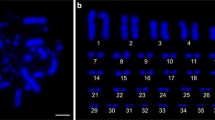Abstract
The correlation between the level of chromosomal abnormalities and demographic parameters has been studied using individuals from a local wildlife population of the bank vole (Clethrionomys glareolus) from a Middle Ural locality in the southern taiga subzone (57°15′ N, 58°44′ E). Variations in the rate of structural chromosomal aberrations, gaps, and changes in the number of chromosomes in the bone marrow cells of the bank vole has been examined using routine cytogenetic methods. The effect of demographic parameters, i.e., population density, age, sex, and reproductive status, has been estimated using log-linear analysis. It has been shown that the share of individuals with an elevated rate of cells that carry structural chromosomal abnormalities and gaps decreases with increases the population size. This pattern agrees with the standpoint that a lower rate of mutations in somatic cells enhances survival of organisms. This pattern can have established as a consequence of natural selection, which induces the rearrangement of the genetic structure in the population or as a byproduct of other processes in the population that accompanies the changes in its size. A high population density leads to an increase in the share of individuals that display an elevated rate of cells with abnormal chromosome numbers among the yearling voles. A similar effect may result from an asymmetric interference competition between adults and yearling individuals. Our results demonstrate that the proportion of animals that display an elevated rate of somatic cells with structural chromosomal abnormalities and aberrant chromosome numbers considerably increases with age, which agrees with both the theoretical concepts and experimental data. Neither sex nor involvement in reproduction has any significant effect on the level of cytogenetic instability.
Similar content being viewed by others
References
Charlesworth, B. and Hughes, K.A., Age-specific inbreeding depression and components of genetic variance in relation to the evolution of senescence, Proc. Natl. Acad. Sci. USA, 1996, vol. 93, no. 12, pp. 6140–6145.
Daev, E.V., Sverdlova, O.L., Matskevich, O.A., and Antonyuk, E.V., Cytogenetic effects of pheromones on bone marrow cells in male Mus musculus L. mice, Genetika, 1995, vol. 31, no. 5, pp. 632–636.
Difilippantonio, M.J., Zhu, J., Chen, H.T., et al., DNA repair protein Ku80 suppresses chromosomal aberrations and malignant transformation, Nature, 2000, vol. 404, no. 6777, pp. 510–514.
Dmitriev, S.G., Zakharov, V.M., and Sheftel, B.I., Cytogenetic homeostasis and population density in redbacked voles Clethrionomys glareolus and C. rutilus in Central Siberia, Acta Theriol., 1997, no. 4, pp. 49–55.
Gao, Y., Ferguson, D.O., Xie, W., et al., Interplay of p53 and DNA-repair protein XRCC4 in tumorigenesis, genomic stability and development, Nature, 2000, vol. 404, no. 6780, pp. 897–900.
Gileva, E.A., Chromatid gap as a marker of mutagenic effect of environmental pollution in commensal and wild rodents of the Ural, Tsitol. Genet., 2002, vol. 36, no. 4, pp. 17–23.
Gileva, E.A., Rakitin, S.B., and Cheprakov, M.I., Genomic instability in the bank vole: population-ecological aspects, Russ. J. Ecol., 2006, vol. 37, no. 4, pp. 271–277.
Griffin, C.S. and Thacker, J., The role of homologous recombination repair in the formation of chromosome aberrations, Cytogenet. Genome Res., 2004, vol. 104, nos. 1–4, pp. 21–27.
Harvey, A.N., Costa, N.D., Savage, J.R.K., and Thacker, J., Chromosomal aberrations induced by defined DNA double-strand breaks: the origin of achromatic lesions, Somat. Cell. Mol. Genet., 1997, vol. 23, no. 3, pp. 211–219.
Krebs, C.J. and Myers, J.H., Population cycles in small mammals, Adv. Ecol. Res., 1974, vol. 8, pp. 267–399.
Krebs, C.J., Population dynamics of large and small mammals: Graeme Caughley’s grand vision, Wild. Res., 2009, vol. 36, no. 1, pp. 1–7.
Morley, A.A., The somatic mutation theory of aging, Mutat. Res., 1995, vol. 338, nos. 1–6, pp. 19–23.
Morris, S.M., A role for p53 in the frequency and mechanism of mutation, Mutat. Res., 2002, vol. 511, no. 1, pp. 45–62.
Nijnik, A., Woodbine, L., Marchetti, C., et al., DNA repair is limiting for haematopoietic stem cells during ageing, Nature, 2007, vol. 447, no. 7145, pp. 686–690.
Olenev, G.V., Determining the age of cyclomorphic rodents: functional-ontogenetic determination, ecological aspects, Russ. J. Ecol., 2009, vol. 40, no. 2, pp. 93–104.
Paashuis-Lew, Y.R.M. and Heddle, J.A., Spontaneous mutation during fetal development and post-natal growth, Mutagenesis, 1998, vol. 13, no. 6, pp. 613–617.
Paz-y-Mino, C., Davalos, M.V., Sanchez, M.E., et al., Should gaps be included in chromosomal aberration analysis? Evidence based on the comet assay, Mutat. Res., 2002, vol. 516, nos. 1–2, pp. 57–61.
Pfeiffer, P., Goedecke, W., Kuhfittig-Kulle, S., and Obe, G., Pathways of DNA double-strand break repair and their impact on the prevention and formation of chromosomal aberrations, Cytogenet. Genome Res., 2004, vol. 104, nos. 1–4, pp. 7–13.
Skorova, S.V., Nazarova, G.G., and Gerlinskaya, L.A., Effects of stress on the frequency of chromosome disorders in the bank vole, Izv. Sib. Otd. Ross. Akad. Nauk, Ser. Biol. Sci., 1986, no. 3, pp. 91–95.
Symington, L.S., Role of RAD52 epistasis group genes in homologous recombination and double-strand break repair, Microbiol. Mol. Biol. Rev., 2002, vol. 66, no. 4, pp. 630–670.
Thacker, J., The Role of homologous recombination processes in the repair of severe forms of DNA damage in mammalian cells, Biochimie, 1999, vol. 81, nos. 1–2, pp. 77–85.
Wojda, A. and Witt, M., Manifestations of ageing at the cytogenetic level, J. Appl. Genet., 2003, vol. 44, pp. 383–399.
Author information
Authors and Affiliations
Corresponding author
Additional information
Original Russian Text © M.I. Cheprakov, S.B. Rakitin, 2012, published in Zhurnal Obshchei Biologii, 2012, Vol. 73, No. 4, pp. 253–258.
Rights and permissions
About this article
Cite this article
Cheprakov, M.I., Rakitin, S.B. Correlation between level of chromosomal aberrations and demographic parameters. Biol Bull Rev 3, 209–213 (2013). https://doi.org/10.1134/S2079086413030043
Received:
Published:
Issue Date:
DOI: https://doi.org/10.1134/S2079086413030043




